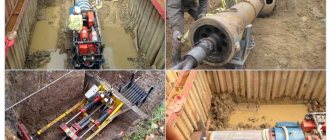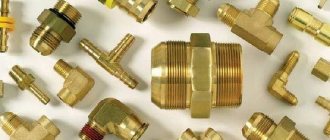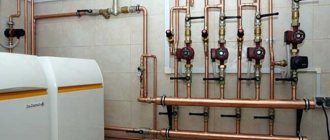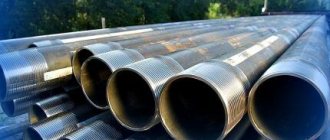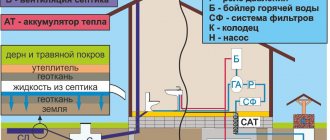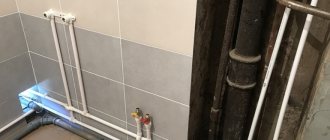Trenchless pipe laying is a method that allows you to install pipeline communications without opening the ground. Thanks to this installation option, disruption to the appearance of the site, the integrity of asphalt roads, destruction of trees, etc. is eliminated. Today, this method includes several possible implementation options.
Laying pipelines using the trenchless method does not require large-scale excavation work
What should be done before laying the pipeline?
Development of the project and its approval is the first stage that the owners must complete. Any construction project must have a detailed, accurate plan for laying communications.
Getting approval
Preliminary coordination with local administration authorities will avoid all problems in the future:
- other communications may pass under the road, and acting at random can easily damage them;
- the initiative is punishable: the master is unlikely to like a serious fine for unauthorized drilling.
An “amateur” connection to the highway without project approval can lead to the same result.
Soil research
If you plan to contact specialists, then such surveys are usually carried out by representatives of a company specializing in pipeline laying. Another option is to invite employees of an organization conducting geodetic work. As a result, the master will know:
- type, composition of soil;
- about the presence/absence of voids, solid inclusions;
- depth of groundwater, direction, speed of its passage;
- potentially dangerous “areas on the site”.
All this knowledge will not be superfluous in any case. If we talk only about laying a pipeline, then awareness of the characteristics of the soil will give a 100% chance of avoiding the collapse of a “freshly made” tunnel.
What is a puncture under the road?
Soil puncture is nothing more than punching (pushing) the soil in the horizontal direction. This option guarantees that the integrity of the road surface will not be compromised. In addition, this process does not require excavation of land. It allows you to lay pipes with a diameter of up to 550 mm, so it is equally suitable for laying water, gas, sewerage, and electrical cables under the road surface.
The desire to avoid unnecessary expenses when laying communications is quite reasonable: construction costs are not small, and horizontal drilling using equipment is relatively inexpensive, but it will still take some money. If you do the work yourself, you can achieve significant benefits - from 30 to 40%. The trenchless installation process itself consists of several stages. This:
Due to the work, the soil under the road becomes denser, but the surface itself remains intact. When the road width is large - over 10 m - a special drilling rig designed for HDD is used. A shorter puncture length makes the work much easier, especially if it is done manually.
Advantages of the method
The popularity and demand for this method of laying water pipes is explained by the following advantages:
- Efficiency of work - compared to digging an open trench, puncturing takes 3-4 times less time.
- Low labor intensity - puncturing does not require significant physical effort and a large number of workers, as is the case with the trench method of laying pipes.
- All-season use - piercing the soil for water supply can be done at any time of the year using various installations.
- Environmentally friendly - this method of laying a pipeline avoids disturbance of the soil structure, damage to tree roots, destruction of natural landscapes, artificial lawns and plantings.
- Low risk of damage to nearby communications (sewerage, communication lines, gas pipelines) - when a puncture occurs, the likelihood of damaging nearby communications is much less than when excavating soil with an excavator or trencher.
- Low cost - even when hiring specialists with special equipment, digging a sewer using the puncture method costs 30-40% less than traditional trenching.
How to lay a pipe under the road: methods
A direct puncture is not the only way to pass an obstacle without any losses. When laying highways use:
To determine how to lay a pipe under the road and which option to prefer, you need to pay attention to a number of factors. These include:
Another point under consideration is the economic feasibility of using a particular method. Since the main requirement in this case is to preserve the integrity of the road section, more often the choice is made on a “puncture”. This method is gradually replacing all other pipe laying technologies.
Types of punctures
The puncture method is used when laying water pipes under the road.
Depending on the mechanisms used and the principle of laying a channel for laying pipes, the following types of puncture are distinguished:
- pushing;
- horizontal directional drilling (HDD);
- auger drilling;
- hydropuncture;
- vibration puncture
Punching
This type of puncture is performed as follows:
- A directional drilling unit is placed in the initial pit, consisting of a frame with hydraulic cylinders that drive a carriage with a drill string - interconnected rods.
- The first to be installed in the carriage is a rod with a working head in the form of a sharp cone.
- Using an oil station (a gasoline engine with oil pumps), hydraulic cylinders forcefully press the first rod into the wall of the pit.
- After most of the first rod has disappeared into the soil, the carriage is pulled back using hydraulic cylinders. Using a threaded connection, screw the next one to the end of the rod, secure it in the carriage and repeat the pushing process.
- When the working head of the first rod of the drill string appears in the final pit, it is removed and a device for fastening and pulling the pipe is installed.
- By pulling out the pipe attached to the first rod, it is laid in the channel (case) drilled in this way.
Horizontal directional drilling
This method is widely used when laying water supply networks with a diameter of up to 200 mm. The puncture is carried out by special self-propelled units on caterpillar tracks, capable of working in conditions of limited space and marshy soil.
The technology for performing horizontal directional drilling consists of the following stages:
- Drilling a pilot well - in this case, the installation deepens a string of rods with a working drilling head in the form of a blade on the first of them at a given angle and punches a narrow channel, reaching the surface or in the wall of the final pit at the end point of the pipeline laying trajectory.
- Sequential expansion of the pilot well - at this stage, the working head is replaced with a special rotating expander (rimmer), which, when pulling the rod string, increases the diameter of the channel to the required value. At the same time, new drill rods are attached to the end of the rimmer - this is necessary so that after expanding the channel, it is possible to conveniently and quickly pull a string of pipes through it.
- Pipeline pulling - a swivel (earring) is installed on the last rod connected to the rimmer, to which the head of the pipe string is attached. The pipeline is pulled by removing the rods using the installation until the end of the pipe appears at the starting point of drilling.
During the work process, a special composition is supplied inside the drill string rods and to the tip (working head), which helps to destroy the rock being drilled, reduce the friction of the rods on the soil, and remove the drilled rock from the well. After completion of the work, the drilling mixture collected in the pit is pumped out, cleaned of rock particles and regenerated with the help of chemical reagents for subsequent use.
Auger drilling
This method of trenchless laying of water supply and other communications is as follows:
- An auger rotating from the installation engine with a working head (blades) in the end part is installed inside the large pipe-case.
- When the pipe is pressed into the wall of the pit, the rotating auger drills through the rock encountered in its path and partially removes it through the end of the pipe.
- After the first pipe has completely disappeared into the soil, the next one with the same auger inside is connected to it;
- When the end of the pipe string appears in the final pit, all the augers are sequentially removed from it with the remains of the drilled rock that was not removed by them.
Several water supply lines are placed into a pipe drilled in this way.
Hydropuncture
This type of puncture is performed using a horizontal drilling installation, in which a special head is placed at the end of the first rod of the drill string, piercing the soil layer in front of it using a powerful jet of water created by a centrifugal pump.
This method is used to puncture loose sandy and sandy loam soils.
Vibration puncture
During vibration puncture, the working body of the pneumatic punch, in addition to rotational movements, also performs powerful reciprocating movements (like a jackhammer). Thanks to this, such installations can quickly and efficiently pierce even the densest clay or loamy soil.
Reconstruction and replacement of the pipeline using the sanitation method
The rehabilitation method is used in cases where the audit process revealed the need for complete or partial replacement of the existing pipeline.
With the help of sanitation, the following problems are effectively solved:
- clogging of pipeline sections and formation of cracks;
- destruction of local branches of communications by tree roots;
- threat of pipe rupture due to corrosion.
Depending on the state of communications and the assigned tasks, they resort to relining or renovation technology.
Relining technology or “pipe in pipe”
Relining is a rehabilitation option used for pipelines in which an insignificant reduction in diameter is possible. If the actual service life of metal pipes has been exhausted and there is concern that they will continue to work until the next breakthrough, then they are first cleaned of calcium deposits, rust and sand.
A polyethylene liner is prepared in the form of a sleeve, which is first filled from the inside with a polymer composition that is evenly distributed along the entire length. This polymer stocking is straightened inside the pipe under water or air pressure, while simultaneously turning it inside out so that the previously applied composition is adjacent to the walls of the pipeline.
After the hose has filled the entire segment of the worn pipeline, the polymerization process is carried out under the influence of temperature. As a result, both the strength of communications and their throughput increase.
Another relining technology involves laying new polypropylene pipes from inside existing old ones. In this way, steel, ceramic, asbestos-cement, cast iron, concrete and reinforced concrete pipelines with a diameter of 200-315 mm are replaced.
Relining is a quick and economical way to update a pipeline and increase its capacity, despite a slight decrease in the internal diameter of the pipes
In this case, it is necessary to take into account that at the junction of PVC pipes a seam of about 15 mm is formed, and from this it is necessary to measure the gap between the inner diameter of the old pipe and the outer surface of the new pipe.
Due to the low hydraulic resistance of plastic pipes, the throughput does not deteriorate even with a decrease in diameter.
Upgrading pipelines using renovation technology
Another rehabilitation option is renovation. It differs from relining in a much less gentle attitude towards existing communications, which are destroyed and compacted into the ground, creating a protective shell for a new pipeline, which often has a larger diameter.
When renovation technology is used, worn-out segments of the old pipeline are destroyed and pressed into the ground, thereby creating an additional protective shell for new communications.
For such trenchless pipe laying, specialized equipment is required - a pneumatic impact machine with an expander cone equipped with cutting ribs is used. The video below the article clearly shows how the cone copes with a 6 mm steel pipe.
The working mechanism is fixed to the traction cable, after which modules made of PVC pipes are gradually attached, the length of which can vary from 600 to 1000 mm, depending on the width of the well. The pneumatic hose is connected to the compressor, after which, together with a safety cable, it is passed through the attached modules.
The entrance to the pipeline being replaced is expanded and a pneumatic impact machine is inserted into it. Moving along the communications, she breaks them, at the same time pulling the laying material behind her.
Features of trenchless technology
Even from the name it is clear that in this case there is no need to dig trenches. But in this case we are talking only about the intersection of a road or railway, or a body of water. The pipeline route is brought to the objects in the traditional way, but there it passes through the ground, so the road surface (or rails, sleepers) remains undamaged.
Advantages of the method
Trenchless installation of sewerage or other engineering systems has undeniable advantages. These include:
- high efficiency;
- relative noiselessness;
- small amount of preparatory work;
- small number of service personnel;
- no need to block traffic;
- the ability to carry out work at any time of the year;
- complete absence of risk of damage to other communications;
- lower costs when compared with the traditional trench method;
- versatility: the technology makes it possible to lay a route in any area;
- reduction of system installation time, since this stage can be completed by professionals within a few days.
The most important advantage of this technology is the absence of serious damage to the environment, because there is no need to restore the road surface.
Disadvantages of technology
Are there any disadvantages? There are none, if we consider the method from the point of view of professional builders. Owners of suburban areas can find relative disadvantages even with trenchless installation. This is the need to hire special equipment and labor costs when the operation is carried out without the participation of special equipment.
A minor drawback can be considered the novelty of the technology, which in some cases may cause workers to be unaware of its features. Another potential problem is the lack of special equipment, but it is fixable.
Areas of use
After the invention of new trenchless methods, the need for a large amount of excavation work disappeared. For this reason, these technologies are used very widely. To make sure that the methods are indispensable, it is better to become familiar with the areas of their application. Types of jobs:
- laying communication cables;
- trenchless sewerage installation;
- installation of underground heating mains, oil pipelines;
- laying gas and water pipelines underground;
- repair or replacement of damaged highway elements.
One type of trenchless laying (HDD) makes it possible to carry out communications in places where the use of other methods is completely excluded. For example, if there is no chance for large construction equipment to arrive, when there is a high probability of landslides in the area, etc.
Equipment, materials for laying
Although there are differences in methods, trenchless installation of sewerage or other engineering systems is an operation during which pipeline sections are pushed into the ground. Therefore, most often a certain set of equipment is used. It includes:
- installations for laying pipes: tracked or pneumatic;
- welding equipment for connecting highway links;
- pipes, nozzles, drill heads, augers, rimmers;
- diesel hydraulic stations (oil stations);
- cameras, monitors for surveillance;
- bulldozers, winches, tractors;
- hydraulic jacks.
Each type of trenchless technology may require additional elements and auxiliary equipment. It all depends on the characteristics of the soil, the features and size of the “overcome obstacle”.
Polyethylene pipes
Characteristics of the material: Polyethylene, unlike steel, is a flexible and lightweight material, it has high strength, is not subject to corrosion and expansion under the influence of temperatures. Thermal conductivity is low.
Price: Polyethylene pipes are one of the most inexpensive and affordable options. The cost of a PE pipe depends on its diameter and length, and on average ranges from 150 to 250 rubles per linear meter (d63 mm)
Suitable type of communications: Polyethylene pipes can be used when laying low-pressure gas pipelines, cable lines and non-pressure sewerage, cold water supply. It is not recommended to use them for heating networks and hot water pipes.
Technological features: Due to the flexibility of a polyethylene pipe, it is much easier to stretch it than a steel pipe. The drilling inclination can be easily changed, making it easy to bypass existing underground communications. In many cases, trenchless work with polyethylene pipes can be started without preliminary excavation work to dig pits or trenches.
Limitations: The depth of laying a polyethylene pipe should not exceed 30 m. The water temperature for a high-pressure polyethylene pipe is no more than 40⁰C, low pressure - 90⁰C. If the soil consists of layers of clay and sand, and there is also groundwater pressure that constantly washes away the layers, then installing polyethylene pipes can be difficult. This will be associated with the floating of pipes to the surface. To avoid this, it is necessary to use heavier pipes.
Advantages: Flexibility, versatility, clean working area, the total cost of laying PE pipes is lower than that of steel pipes.
Disadvantages: There are restrictions on depth and type of soil, there are temperature restrictions.
Specifics of laying sewerage using the HDD method
The construction of a pilot sewerage pipeline is carried out strictly in accordance with the design documentation and under the supervision of an experienced professional. At this stage, it is necessary to monitor the slope of the drill and its trajectory. In case of small errors, the drill's departure is corrected, and after pilot drilling is completed, the channel is widened and the pipes are pulled.
At the final stage of HDD, the gravity sewer has a somewhat horizontally curved appearance and is not completely visible to light. However, even taking this factor into account, trenchless installation has excellent results, minimal errors and risks of emergency situations. As a rule, a gravity sewer network is laid at a depth of 3.5-4.5 m, and this method is used even in sandy or watery soils where digging trenches is not possible.
Laying sewerage using the HDD method is considered the optimal method due to various factors. Our professionals will ensure the development of qualified design documentation and implement it using modern drilling equipment. We have successful experience in laying gravity networks, and will provide installation even in the most difficult soils.
Prices for gravity sewerage using the HDD method
| Diameter of the pipe being laid | Cost of laying 1 meter of pipe including VAT |
| 63 mm | 800 - 1,800 rub. |
| 110 mm | 1,000 - 2,500 rub. |
| 160 mm | 1,800 - 4,000 rub. |
| 225 mm | 2,500 - 6,000 rub. |
| 315 mm | 3,500 - 7,000 rub. |
| 400 mm | 5,000 - 10,000 rub. |
| 500 mm | 6,000 - 12,000 rub. |
| 630 mm | 8,000 - 16,000 rub. |
| 710 mm | 12,000 - 20,000 rub. |
| 800 mm | 15,000 - 23,000 rub. |
ATTENTION! The cost of HDD work does not include: the cost of pipes, preparation of the starting and receiving pits, as well as excavation of communications at the site.
Price calculator
Leave a request for an estimate. For free!
HDD drilling rigs
HDD drilling rigs are modern high-tech complexes for laying utility networks using a closed method.
HDD drilling rigs are a unique technique that has many complex hydraulic units on board, which is capable of performing almost any task in constructing closed passages using the HDD (horizontal directional drilling) method. A drilling head with a built-in electromagnetic sensor, screwed onto a rod, is driven by hydraulic motors mounted on a carriage. Drilling complexes are capable of constructing a well with a diameter of more than 1.5 meters and a length of up to several kilometers; prices for HDD drilling depend on many parameters.
articles:
- HDD drilling rigs Goals and objectives
- Advantages and disadvantages
- Vermeer
Goals and objectives
The purpose of HDD is the construction of closed crossings for further installation of utility networks in areas where open installation is impossible:
- under highways,
- under parks and forest areas,
- under the railway tracks and infrastructure of Russian Railways,
- under the metro lines,
- under rivers, lakes and other bodies of water,
- within the dense location of city communications,
- in other places where open laying is not possible.
The finished drilling channel or, in other words, a borehole is used for subsequent tightening of HDPE pipes inside for the purpose of laying water supply, sewerage, electrical cables, communication cables, heating networks, gas pipelines and other networks.
Advantages and disadvantages
HDD drilling complexes have high productivity, this makes it possible to carry out work on the construction of utility networks in difficult areas much faster than the mechanized method (excavators, etc.), which gives a tangible economic effect.
Advantages of HDD:
- Complex intervals of more than a kilometer in the construction of underground communications are completed in a short time.
- Reduced costs for a large number of workers involved in the process compared to the open laying method. One drilling complex and five workers can pull several kilometers of pipes into a well within two weeks.
- HDD technology allows you to cross many utility networks at depth at a safe distance and ensure that there is no damage to underground communications.
- If special equipment is used correctly, HDD work is feasible in geologically complex soils.
- The HDD method ensures the safety of asphalt-concrete pavements, paving stones, lawns, parks, and landscaped areas, while at the same time allowing the work to be completed.
Disadvantages of HDD:
- The cost of laying one meter of HDPE pipes using the HDD method is 3 or more times higher than the open method.
- In the event of unsuccessful completion of work at the HDD construction site, due to the collapse of the drilling channel, loss of tools and broken pipes in the well, it is impossible to re-perform the work on the project. It is necessary to agree on a change in the project, retreat from the constructed drilling channel and build the well again.
Structural elements of HDD installation
Design of horizontal directional drilling complexes:
- Chassis, hydraulic cylinders driving the tracks.
- Diesel engine that powers all major components.
- Drilling complex operator cabin, levers and control devices.
- High pressure pump for supplying bentonite under high pressure through rods into the well.
- A carriage is a metal beam along which a carriage moves, driving the rods. Provides drilling inclination angles from 0 to 40%.
- Rod cassette, rod feeder to increase the length of the rod column in the channel.
- Set of drilling tools: drill head, expanders of diameters 250 – 700 mm and more.
- Anchor anchors. They are drilled into the ground and allow you to securely fasten the HDD installation to the surface.
Manufacturers of drilling rigs and model range
The largest production of drilling complexes is organized in the United States of America and the European Union. There are also manufacturers from China and Russia on the HDD installations market.
Progress
The piercing process itself is a cyclic pressing - the jacks alternately switch to forward and reverse motion. The impact on the pipe is carried out through the head with clamps, cleaning rods or replaceable pressure pipes.
Using nozzles with a length of 1 to 4 m, completely pressing the pipe to the length of the rod stroke, it is returned to its original position and a double-length nozzle is placed in the resulting opening.
This process is repeated until the first section of pipeline is punctured (usually 6 m). After this, the next link is attached to it and the operation is repeated.
Auger drilling
This is another answer to the question of how to lay a pipe under the road. In this case, the hydraulic unit acts as the main working unit. This trenchless pipeline installation differs from the previous method.
Pipes or cases are immediately installed inside the tunnel. The maximum diameter of such holes is 1720 mm.
DIY drill for HDD
The main element of the HDD installation is the drill; it is the drill that bears the main function of the drilling process. The drill can be purchased at a specialized construction equipment store. But, since we decided to make the HDD installation ourselves, we will try to cope here ourselves.
To make a drill you will need the following:
- a durable pipe with a diameter of up to 5 centimeters and a length that will correspond to the length of the required well;
- two small tubes with a diameter of 4-5 centimeters and a length of 10-12 cm (future handle);
- a piece of sheet steel with a thickness of at least four millimeters;
- machine for cutting hard metals;
- electric welding machine;
- burner (blowtorch).
Let's start making an HDD drill with our own hands:
- We cut a circle from a piece of sheet steel so that its diameter coincides with the diameter of the future well.
- In the central part of the circle we make a hole the size of the main pipe.
- We remove one segment from the resulting ring. Its size depends on the size of the stones that prevail at the drilling site.
- Using a sledgehammer, we “roll” the steel ring into a spiral shape. The extreme cutting part must be sharpened for more efficient drilling.
- Now you need to make the tip. This can be done using a small piece of sheet steel. We heat the steel with a torch, having previously clamped it in a vice, after which we give the piece of steel the required shape.
- We weld the resulting tip to the end of the main pipe. The tip should be like a continuation of this pipe, increasing its length.
- Weld two pipes to the main pipe, which will serve as future handles.
Stages of work when performing HDD with your own hands
Performing horizontal directional drilling using a homemade HDD installation is carried out in several stages:
Preparation.
At this stage, two holes (small pits) are dug parallel to each other, opposite an obstacle (a road, for example). The depth of the pits should be approximately 20-30 centimeters greater than the planned depth of pipe laying.
Pilot well.
At this stage, a preliminary well is made between the pits. The first piece of pipe is taken, the pipe guide needs to be sharpened using a grinding machine. The pipe is driven with a sledgehammer with the sharp end towards the receiving pit. Having hammered the pipe completely, the next section of pipe is welded to its end and also driven in. This continues until our tip appears in the receiving pit.
The driven rod, between the starting and receiving pits, subsequently serves as a guide axis.
The final stage.
The pipe is driven in again, similar to the previous stage, but larger. After that, using a pump, excess soil is washed out of the pipe under pressure.
It is worth saying that such DIY HDD requires a lot of labor and patience. To make a horizontal well, even a small one, requires a lot of effort.
Features of the horizontal directional drilling process
1. HDD - a trenchless method of laying sewerage using horizontal directional drilling begins with drilling a pilot well. Preparation of the process includes the construction of pits at the entrance and exit of the drill, installation of drilling equipment at the drilling point and a drilling fluid preparation unit. The process occurs with the tracking of the drill’s trajectory by the location operator.
The working part of the drilling rig is a drill, which is pushed through the soil thickness by force from a rotating drill rod. The bentonite-polymer mixture flows through its longitudinal channel. Thanks to the solution, the walls of the well are strengthened, the bit is cooled, and the removal of destroyed soil - cuttings - is ensured. During pipe pulling, bentonite significantly reduces soil resistance, i.e. reducing the effort of the drilling machine to insert the pipeline.
Horizontal directional drilling
2. The next step is to expand the well. The drilling tool for this operation is a reamer, which is attached to the drill rod in place of the removed drill head. Thanks to the traction force and simultaneous rotation of the expander, the valve expands by ≈ 25–30% of the pipeline diameter. The process occurs when the well is drilled back towards the drilling rig.
Let's consider the classification of the main methods.
A group of uncontrolled methods. Drilling can be carried out:
Tunneling machines performing haulage:
- flushing;
- screw;
- with suction.
Flushing drilling.
Occurs by washing with bentonite. The probe is controlled.
Pilot drilling followed by:
- dry or wet expansions;
- expansion in rocky soil.
Let's briefly look at the key principles and points of laying pipes using trenchless methods.
Auger drilling (or auger drilling) is widely used in industry and construction. This is especially true in cramped conditions. The case is pressed simultaneously, removing excess rock. The possibility of collapses is also prevented.
The advantages include the integrity of the soil surface and the environment, operability in various rocks and in any weather, the creation of a channel of the required length and diameter, and there is no soil subsidence.
The simplest drilling rigs will do. Their basis is a drill head with augers located lengthwise behind it. Motors can be electric, hydraulic or pneumatic.
The price of HDD of this type allows you to minimize costs. The estimate includes a calculation of each stage and takes into account the conditions.
Pilot drilling. They resort to it in cases of laying routes and routes for pipelines for industrial purposes. In installations for this type of operation, the drill heads are beveled. Can be equipped with special nozzles for supplying bentonite. A special sensor located in the head part determines the trajectory of movement.
Any trenchless pipe laying has a number of its own special, undeniable advantages that set it apart from others:
- versatility for any type of task: from pipelines in desert areas to densely built-up urban areas;
- high-precision technologies guarantee the accuracy of laying any type of communications;
- the length of the tracks is up to hundreds of kilometers, the diameter is from 12 m and above;
- Heavy equipment and many workers are not needed, therefore, labor costs are minimized. One installation and no more than four workers is all that is needed;
- HDD pricing policy allows you to save up to 50% of finances and terms up to 20 times;
- the possibility of damaging nearby networks is minimized;
- At the same time, the walls of the shaft are laid and strengthened. This is facilitated by special solutions in combination with soil compaction;
- mountains, rivers, foundations of houses, etc. - no problem;
- no dependence on weather conditions;
- environmental friendliness: the top layers of the soil are absolutely not damaged.
It is better to entrust such an important and responsible task to highly professional specialists, since a number of conditions must be met: the presence of special installations, trained employees with appropriate qualifications. Also knowledge of regulatory documents, conducting geological exploration studies. We have everything necessary from the above list, most importantly, vast experience in this industry, we undertake the coordination of all technical documentation
And this is the best guarantee of quality and durable, uninterrupted operation.
We have everything necessary from the above list, most importantly, vast experience in this industry, we undertake the coordination of all technical documentation. And this is the best guarantee of quality and durable, uninterrupted operation.
HDD price. As for payment for work, in each specific case the estimate is drawn up taking into account the specifics of your order, and the price is determined individually. The final score is influenced by the type of soil, the required length of the mine, and materials.
Our experts and the wide range of unique technologies for trenchless pipe laying will solve all your difficulties and eliminate unnecessary headaches in the shortest possible time. And during this time you will live at your usual rhythm.
Modern construction companies engaged in laying pipelines and other communications are gradually minimizing the use of the trench method, which is losing its relevance, preferring new, time-tested, unique developments. Thanks to new technologies, today it is possible to carry out complex construction work without causing harm to surrounding objects, without large financial investments.
How to make a puncture yourself?
As already noted, this manual method is used, but only if the width of the roadway does not exceed 10 m. In this case, the master will need good physical training, but even “Hercules” will not be helped by assistants. Before considering in detail the question of how to lay a pipe under the road, you will have to start looking for equipment, tools and materials.
What will you need to find?
For the operation you need to collect everything you need. The list includes:
You will also need to purchase several pieces of steel pipes of the required diameter.
How to make a puncture with reinforcement?
The process of laying a pipeline manually includes several stages.
After completing the wiring, the trenches and pits are buried, then the soil is thoroughly compacted.
How to lay “pipes with a pipe”?
In this case, you will also need to purchase materials, and you can make the attachment for the working tool yourself. For the puncture you will need:
This technology is also simple, so the stages of difficulty do not promise. First, a tip is made from tool steel and welded to the pipe.
The final operation is cutting off the tip and deformed end of the pipe with a grinder. If they are going to remove it, then this part of the work is done directly during the laying of the pipeline, otherwise a collapse is possible.
Help from a hand drill
This is another, relatively simple option for those who are not satisfied with the previous methods. In this case, the master will need to purchase a two-meter hand drill: a meter of tool plus a meter of extension. You will also need:
The work looks like this step by step:
If the soil under the road is not too pliable, then it is recommended to make a small excavation from the exit trench in advance, and then securely strengthen it with boards. When the soil at the work site is rocky, obstacles may arise that will have to be heroically overcome.
Benefits of technology
Trenchless technologies, unlike other methods of conducting utility networks, have a number of advantages. Among them:
- Low cost. If there is a puncture after completing the work, there is no need to restore the asphalt surface or dig a trench.
- Minimal risk of damage to previously laid communications.
- Small time investment.
- Possibility of communications in densely built-up areas.
- Minimum amount of labor.
In addition, thanks to the trenchless method of conducting communications, the environment is not harmed. When laying utility networks, it is not necessary to disturb the top layer of soil and green spaces.
Horizontal directional drilling saves money and time. Unlike the trench method of conducting communications, there is no need to dig a trench, which reduces the work time. When puncturing the soil, there is no need to violate the integrity of the asphalt pavement, underground and surface communications.
Horizontal directional drilling does not require stopping the movement of vehicles and the operation of other communications.
The HDD method also reduces time, since there is no need to dig a trench. The speed of operation is twice as fast. The cost of work when puncturing the soil, in contrast to other methods, is 30-50% lower. This is due to the fact that digging trenches requires time and money, and also does not require transportation and disposal of soil.
Performing soil piercing when working with private customers requires the use of small diameter pipes. The length of the pipeline is from 50 meters.
Directional drilling, HDD technology
Our company is a leader in the construction of pipeline laying using horizontal directional drilling. We cooperate with reliable suppliers. Our highly qualified specialists perform the work quickly and efficiently.
HDPE pipes for HDD
The diameter of the pipe for HDD is standard: 63, 110, 160, 225, 315, 400, 500, 600, 700 and 800 mm. According to the technical standards of SNiP, if the minimum pipe diameter is 273 mm, the use of longitudinal or spiral welded structures is required. For additional protection from external factors, it is necessary to use special cases made of hot-rolled steel. With a maximum pipe diameter of 200 mm, the use of polyethylene protective cases is allowed. The specifics of laying and the choice of material directly depend on the properties of the soil:
- Soil based on sand and clay may have groundwater that washes away layers of soil. The use of lightweight plastic pipes in such a situation is impossible. To prevent them from floating, heavier materials must be used.
- The depth of the bookmark is also important during installation. To install a network to a depth of 4.5 meters and a length of 45 meters, a steel pipe with a length of more than 120 meters will be required.
- For laying communications using the HDD method, polyethylene pipes are the most suitable. The maximum depth for such material is limited to 30 meters.
To lay communications using the HDD method, you can use pipes made of any material except concrete. Cast iron was not used in this installation method for a long time due to its heavy weight. However, modern developments have made it possible to modernize drilling rigs and increase their traction force to 45 tons.
Pros and cons of trench laying
To understand why trenchless installation of sewerage and other engineering systems is now actively used to overcome various obstacles, we need to dwell briefly on traditional technology.
Advantages of trenches
Tradition is the main advantage. In this case, I was attracted by the simplicity of the work and the undemanding nature of the performers, if you do not mean physical strength. But in most cases it is not important. The reason is the ability to transfer most of the work to available equipment, because hiring an excavator or bulldozer is usually not difficult. This is where the list of advantages ends.
Disadvantages of the usual method
There are more of them. The disadvantages include:
- the need to stop traffic in the area chosen for work;
- serious temporary losses due to the dismantling of the coating and then its restoration;
- death of plants due to damage to the root system, destruction of the fertile soil layer.
However, the main disadvantage of trench technology is the inability to bypass serious obstacles - bodies of water, wide busy highways or railway tracks. For this reason, trenchless methods have no alternatives.
How to lay a pipe under a road: technologies are simple, fast and labor-intensive
During the construction of a house and landscaping of a plot, land owners have to solve many problems. Very often, difficulties are associated with laying various communications where there is an almost insurmountable obstacle: for example, a railway track or a roadway. In this case, a natural question arises about how to lay the pipe under the road. There are several methods for solving the puzzle, but the most popular technology remains “puncture under the road.” You can do it yourself, but first it’s better to get acquainted with this method of trenchless installation of communications, and then learn about alternative options.
Types of trenchless pipe laying
The method of laying the pipeline depends, in particular, on the length of the section where the water supply or sewerage system is required. For example, if the planned length of such a system does not exceed several tens of meters, the work can be carried out without the use of specific equipment.
It will be enough just to make or find a closed cylinder of the required diameter (of course, the size should be slightly larger than that of the pipe being laid) and attach it to a retractable rod operating on a pneumatic, hydraulic or electric drive. With the help of this simple equipment, work can be carried out quite quickly, but you will have to dig pits of the required depth along both edges of the designed trench.
Basic installation methods
Laying of any pipeline can be carried out in the following ways:
Open method. The main is installed on supports or its location is a through or non-through collector.
Open laying
- Using a closed or trenchless method. Laying the pipeline does not require first opening up the soil.
- Underground method of laying a pipeline. Trenches are made into which the drainage system is installed.
Installation of water supply in a prepared
These types have their advantages and disadvantages.
Insulation of sewer pipeline
The efficiency and durability of external sewerage largely depends on properly performed insulation
This is especially important in northern regions and when pipes are laid above the freezing level. To understand how important insulation is, you need to imagine how the system works in the cold season
During the passage of liquid, which always has a positive temperature, the pipe is partially filled with liquid waste. Water vapor also fills the pipe.
In winter, at subzero temperatures, the part of the pipe located closer to the surface cools, which leads to the formation of condensation, and then frost, which rushes to the center of the pipe, which often causes blockages.
Molded insulation is selected based on the diameter of the pipe, before laying the sewer line, it is simply put on top
Insulation materials can be rolled or molded. The first are wound onto the pipe while it is being laid in the basement. Thermal insulation shell made of foamed polyethylene has a similar application.
They are not used as thermal insulation for underground lines. Mostly molded insulation is used, which is made for a specific pipe diameter. Thermal insulating material of the required diameter is simply placed over the sewer pipe.
One of the most popular insulation materials is Energoflex, which is made from extruded polystyrene foam. The closed cell structure of the material prevents the penetration of groundwater, which can significantly reduce the insulating properties. Foil casing enhances efficiency
If the temperature in the region is very low, then insulation alone is unlikely to be a reliable protection of pipes from freezing. In this case, a heating cable is usually used, which is laid along the outside of the pipe inside the heat-insulating material.
When using a heating cable, you need to ensure that the joints are completely sealed to prevent moisture from leaking inside.
Stage-by-stage implementation of HDD
The drilling process requires careful attention, control, and adherence to technological features at every stage.
Preparatory work
Before laying underground communications, the landscape and equipment must be prepared:
- Equipment of a platform for a drilling machine of universal size 10x15 m;
- If necessary, prepare a detour route for the car;
- Installation of drilling equipment and pilot rod directly at the point where the drill enters the soil;
- Fixing the tool with anchors on a level surface to avoid displacement or mobility during HDD;
- Adjusting the tool according to the angle of inclination using an expander, leveling the drill head for a smooth entry into the soil;
- Debugging radio communications between team members;
- The pits are equipped with additional drainage for bentonite liquid and groundwater if there is too much of it.
At the preparation stage, it is important to calculate the location of existing pipelines so as not to damage them during excavation work. When installing installations for mixing bentonite and drilling, it is necessary to maintain a distance between them, the minimum distance is 10 m
Before piercing, you should study the composition of the soil and select the appropriate tool for successful passage of the drill head through the soil. The entire work location, where special devices are installed, as well as at the drill exit site, is fenced off with yellow warning tape.
Laying pipelines and other communications
After the preparatory work, they begin HDD:
- A pilot well with a cross-section of 10 cm is laid;
- Debugging equipment, adjusting the tilt of the drill head by 10 - 20° relative to the horizon;
- Passing the drill, checking the trajectory every 3 m and adjusting the direction of the tool;
- Pilot well reaming: the original tool is removed from the puncture and replaced with an expander;
- Complete passage of the expander through the resulting channel with constant adjustment of movement.
During HDD, the use of drilling fluid is mandatory. The function of the composition is to soften the soil for the simplest passage of a tool through it.
It is important to consider the possibility of soil shedding. To avoid disruption of communication technology, it is necessary to connect all parts of the pipes securely to each other so that soil pressure or crumbling fragments do not violate their integrity
Punching method and shield penetration technology
These technologies are also quite often used when it is necessary to assemble pipelines under obstacles. Laying a pipeline using the pushing method allows you to overcome obstacles up to one hundred meters long. In this case, the open end of the pipe is pressed into the ground. The earth plug that forms inside it is removed.
The tunneling shield consists of a support, knife and tail parts. The second ensures cutting off the rock and deepening the structure into the massif. The supporting part has the form of a ring and is designed to give the structure the necessary rigidity. The control panel is located in the rear section.
Sanitation
The essence of the pipeline rehabilitation method is the trenchless replacement of old pipes with new ones.
There are two main types of rehabilitation.
Sanitation by relining
In this case, modern pipes made of high-molecular compounds (polymers) are pulled into an already equipped pipeline. This, in turn, can be done in two ways: without cutting the old pipes or with one.
In the first case, when the diameter of the new elements is slightly smaller than the original ones, it is necessary to inspect the inner surface of the pipes before starting work in order to prevent damage to the plastic pipes by obstacles located inside the old elements or complete inhibition of work.
The second option is used when it is necessary to lay pipes of large diameter, greater than or equal to the previous one. Then statistical hacking of the old design is used.
The work order is as follows:
- Along the edges of the area where work is planned to be carried out, recesses are dug (about 2x3 m in size).
- From the initial recess, retractable rods are drawn, at the working ends of which (in the same hole) a knife for expansion is fixed, which is fastened with a swivel to the pipe being laid from HDPE (low-density polyethylene).
- In the final pit, hydraulic jacks are installed on the frame, with the help of which the reciprocating movement of the installed rods is carried out. For additional reliability of the structure, the frame with jacks can be installed on a concrete slab.
- The drawing process begins, lasting until the moment when the knife comes completely into the final pit.
- Periodically, 1.5 m long rods are pulled out of the trench and cleaned of dirt.
As a result, the old pipes are cut with an appropriate knife, expanded, and a polymer pipe is inserted into them.
When carrying out relining, several recommendations must be taken into account:
- at the process design stage, the cross-section of the new HDPE pipe to be laid should be carefully selected;
- sections of new pipes measuring 10-12 m are welded on the surface and then carried into the system to be rehabilitated;
- the total length of the welded section should not exceed 0.7 km;
- When selecting the diameter of pipes and taking measurements, it is necessary to take into account the collar formed during welding, which in some cases reaches 15 mm.
Restoration of a pipeline using the relining method is allowed only in cases where a small change in the diameter of the pipeline is permissible or its throughput, due to the advantages of low-density polyethylene (smooth internal surface and low hydraulic resistance), increases.
Renovation
This option is accompanied by the complete destruction of old structures with the simultaneous laying of new pipes. This method is used when the old pipeline either cannot meet the increased capacity requirements or is too dilapidated. Using the renovation method, it is possible to lay pipes of both larger and smaller cross-sections than the original ones.
This method also exists in two versions: replacing old pipes with new HDPE pipes with threads, or destroying the pipeline.
In the first case, it is possible to replace a specific damaged section of the pipeline. The faulty section of pipe is cut with roller knives, the tunnel is enlarged using an expander, and then new pipes are inserted.
In the second option, the pipeline, as with relining, breaks in a static way.
- no need to dig new tunnels - you can use already equipped communication systems;
- it is almost impossible to damage other pipelines during work;
- you can change the diameter of old pipes to meet modern requirements;
- the costs of carrying out land and restoration work are minimal.

